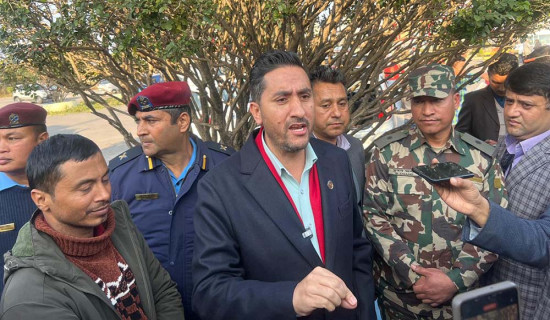- Saturday, 3 January 2026
Machhindranaths Of The Valley
Aashish Mishra
Patan’s famous Rato Machhindranath (Padmapani Lokeshwor) Jatra is set to begin next week. The idol will be placed on its wooden chariot at Pulchowk on Sunday and the pulling of that chariot will begin on Wednesday. Provided the COVID-19 pandemic does not take a sudden and drastic turn for the worse, this year, the Jatra will be held in its unabridged form after a break of two years.
A month earlier, in Kathmandu, another chariot festival for the Seto Machhindranath (Aryawalokiteshwor) was held amid much fanfare.
These two Machhindranaths are arguably the most famous manifestations of the deity but they are not the only ones. Mythologically, they are believed to be 108 incarnations of the god Lokeshwor or Matsyendranath (Machhindranath) and four are worshipped with special significance in the Kathmandu Valley – Adinath of Chobhar, Padmapani Lokeshwor of Patan, Aryawalokiteshwor of Kathmandu and Srishtikanta Lokeshwor of Nala. Of these four, the former two have red-coloured idols while the latter two have white idols.
All four gods are taken around their respective cities in chariots too. But the kind of chariot used varies. The Rato Machhindranath and Seto Machhindranath of Lalitpur and Kathmandu respectively have wheeled chariots which are pulled by devotees while the Nala Machhindranath gets carried around in a palanquin. Scholars and historians say that Nala too used to build a wheeled chariot for its Lokeshwor but the tradition died out. Meanwhile, for Chobhar’s Adinath, priests transfer the god’s consciousness from the idol into a holy urn (Kalash) through special Tantric rituals and parade that urn around the local neighbourhoods.
All four Machhindranaths and in fact all 108 Lokeshwors are worshipped as gods of compassion (Karunamaya). Nevertheless, the four also have their own individual significance. Adinath is believed to be the oldest among the four, hence the title ‘Adi’ which means first or pioneer in Sanskrit. It is considered to be a form of Maha Manjushree, the semi-divine person who cut open the Chobhar gorge with his sword and drained the lake that was Kathmandu Valley. Padmapani Lokeshwor is regarded as the god of rain and good harvest. Aryawalokiteshwor is the god of plentifulness. As the story goes, a farmer discovered its idol while ploughing his field in Jamal. He took it home and put it in a container full of rice. By virtue of the divine statue, the container never emptied no matter how much rice the farmer and his family took out of it. This is supposed to highlight the role of Seto Machhindranath in preventing famines. Srishtikanta Lokeshwor is revered as the creator of all life in the universe.
Likewise, all four gods are also prayed to as the patron divinities of the respective localities they are based in. Adinath resides in Chobhar and hence, is worshipped as Choba Dya, the god (Dya) of Chobhar. Padmapani’s temple is in Bungamati and is called Bunga Dya in Nepal Bhasa. It is to be noted though that it only spends half the year at Bungamati and for the other half, has another temple at Tabahal, near Tangal in the core city of Patan. Aryawalokiteshwor has its temple in Janabahal and is known among the natives of the valley as Janabaha Dya and Srishtikanta is worshipped as Nala Dya.
The Rato Machhindranath Jatra of Patan, though, has particular significance as it involves almost every city of Kathmandu.
When its chariot is pulled to Gabahal, the residents of Kathmandu celebrate the Jatra, when it is pulled to Sundhara, the people of Bhaktapur celebrate Jatra, when it is taken to Lagankhel, the locals of Lalitpur celebrate and when it is taken to Jawalakhel, the rulers and the entire country celebrates.
What is special in Patan is that one Lokeshwor is accompanied by another. The chariot of Padmapani Lokeshwor travels around the city with the chariot of Jattadhari Lokeshwor, better known as Minnath or Chakubaha Dya.
The latter has been worshipped in the city since before the arrival of Machhindranath and is the one who brings Karunamaya into the city from Pulchowk.

















